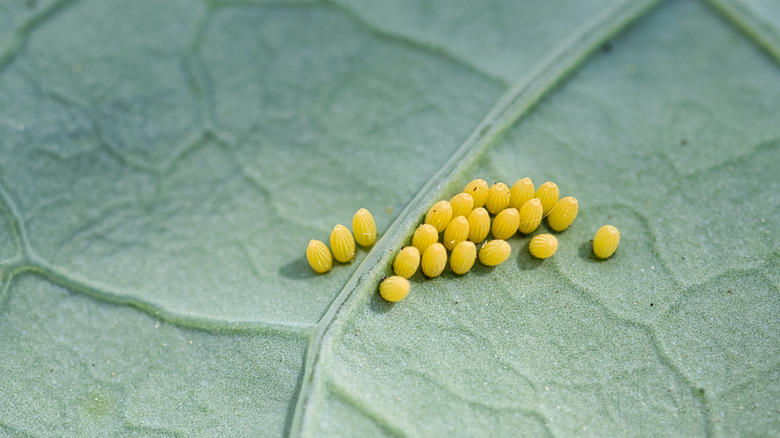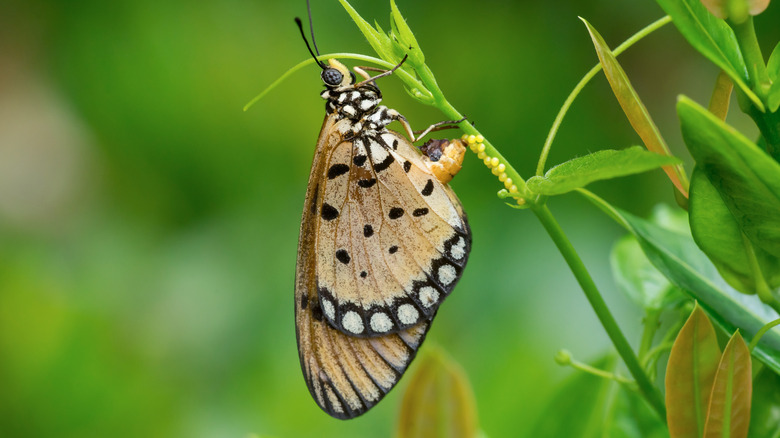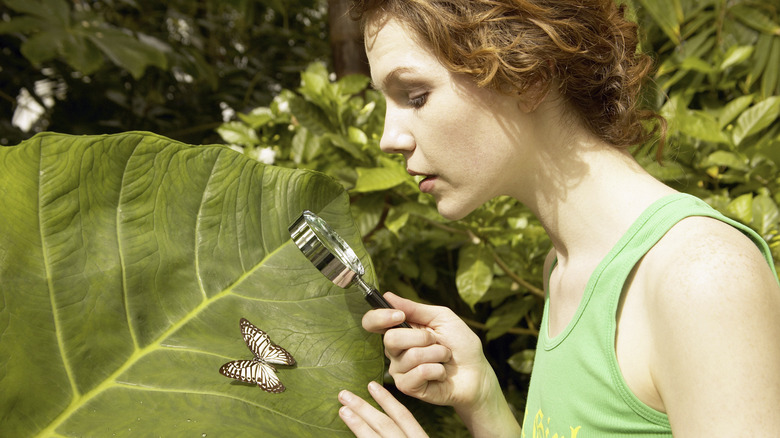How To Spot Butterfly Eggs In Your Garden
Identifying butterfly eggs is a handy skill for any gardener — whether you want the flamboyant insects and their progeny in your garden or not! If you're designing your garden to help butterflies thrive, seeing eggs can indicate your methods are working. Butterfly egg spotting knowledge can also help you harvest hole-free cabbages and cauliflower. It's pretty straightforward: all you need to do, is regularly check the undersides of leaves and stems of your plants for pale eggs about the size of a pinhead.
Butterfly eggs typically range from white to yellow-green, though there are a few sunset-colored outliers. This can make them a little hard to spot against green leaves, and that's for good reason — very few eggs achieve maturity — according to The National Wildlife Federation, the survival rate for monarchs is just 10%, due to predation, climate extremes, or host plant death. Some species of butterfly lay their eggs in clusters, while others deposit one egg at a time on the underside of leaves and axils, flowers, or plant stems. To the naked eye, most butterfly eggs look smooth, but if you look at them under magnification, you'll see they are often ribbed or dimpled. These patterns are the aeropyles (breathing tubes) and micropiles (sperm receptacles).
The importance of host plants
The egg is the first stage in the four-stage butterfly life cycle, consisting of egg, larva, pupae, and adult. After a female adult butterfly has mated, it will start to look around for somewhere to lay its eggs. It turns out butterflies are pretty fussy — most species prefer just a few (sometimes even one) plant species — called host plants. All vegetation, whether vegetables, flowering bulbs, or trees, releases toxic chemicals that deter herbivores. The larvae of each butterfly species have evolved to process the toxin of particular plants, and it's those plants the female butterfly lays its eggs on. Butterflies recognize the correct plants by sight and touch through chemoreceptors on their feet.
Most states have lists pairing butterfly species with their host plants, like this one from Alabama Butterfly Atlas. Once you have identified or planted the host plants of your choice, look for butterflies hovering around them, close to the leaves or stems. When a butterfly lays an egg, it arches its abdomen toward the leaf or stem surface. If you're very observant, you might even see the butterfly scratching a leaf or stem — it's working those chemoreceptors! Butterflies lay their eggs in every season except winter, and the eggs gestate anywhere from a few days to two weeks. However, some eggs can overwinter, waiting until the weather warms and leaf buds emerge to hatch and start munching.
Leave no leaf unturned
Ready to go butterfly egg hunting? You'll need to channel your inner entomologist. Grab a magnifying glass, a camera (ideally with a macro function), and a pen and notebook, and head outside into your garden. Since butterfly eggs are teeny tiny, you'll have to get up close and personal with your plants. Focus on the undersides of all the leaves to start, then peruse the flowers and stems. Take photos and write down the details of any finds —egg shape, size, color, texture, host plant, location — in your notebook, along with the date. Over time, you'll develop a deep understanding of which butterflies inhabit your garden and when.
If you want to find the eggs of a specific species of butterfly, you'll need to educate yourself on its peculiarities. The cabbage white, one of the world's most common butterflies, prefers brassicas and lays a cluster of yellow eggs. Eastern tiger swallowtail eggs are spherical and have a pearly light-green color. They prefer poplars and wild cherries as host plants. Useful directories, like Butterflies of America or Butterflies and Moths of North America (BAMONA), are treasure troves of information on the insect order Lepidoptera — the order moths, skippers, and butterflies fall under.


